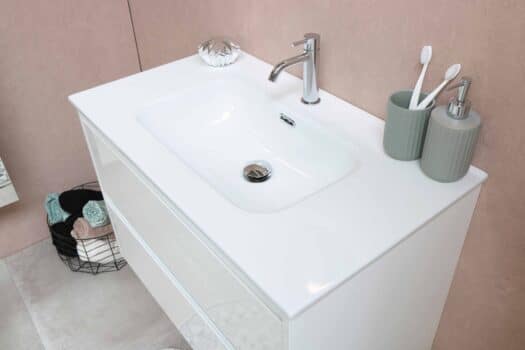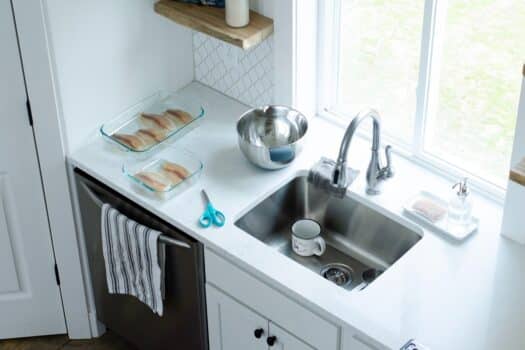When upgrading your kitchen, the kitchen sink faucet is as important as the backsplashes and appliances.
As you must know, the primary task of a kitchen sink faucet is to dispense water to carry out a variety of chores uninterruptedly. So, installing a high-end artistic-style faucet and an innovative yet functional sink can be a focal point for your kitchen.
Of all the kitchen sinks, the undermount ones are the most popular pick among homeowners because they boast a clean and modern design and give plenty of counter space.
The only caveat of undermount sinks is that they don’t come with pre-drilled faucet holes, so you’ll have to undertake some DIY tasks to make them fully functional. That being said, here’s a short guide on how you can install faucets in undermount sinks without calling for professional help.
So, let’s dive straight into the deets!
A Guide To Making Holes On An Undermount Sink

While the majority of homeowners prefer undermount sinks because of their aesthetics, some dread the installation because they don’t feature pre-drilled holes. This means anyone who opts for such a sink will have to determine the location and drill holes themselves to install a faucet.
But, don’t worry; we’re here to help you determine the number of holes you must drill to make the sink fully functional.
How Many Holes Should You Drill In An Undermount Sink?
Are you wondering how to install a vessel sink faucet on your new undermount sink? Then let us tell you that the first thing you’ll have to do is drill holes. Of course, the number of holes you drill depends upon the faucet you opt for.
For vessel and single handle faucets, you’ll need to drill only one hole. But, if you’re installing a traditional double-handed faucet, you’ll have to drill three holes. On the contrary, bridge-style faucets require two holes for proper installation.
The distance between the handle and the spout is typically eight inches for kitchen sinks. Irrespective of whichever style faucet you install, refer to the product instruction manual to know the exact space you must leave while drilling holes.
Along with faucet holes, you may have to drill a few more holes to install other accessories, which are as follows:
1. Sprayer Or Soap Dispenser
A sprayer or soap dispenser is one of the most useful accessories in the kitchen, for it makes cleaning an easy task. Homeowners can dispense soap with one hand while doing the dishes when installed on the kitchen sink.
Thus, you’ll have to drill one hole in the kitchen sink to position the soap dispenser for ease of use.
2. Air Gap
Ideally, it is mandatory to have an air gap in the kitchen sink to prevent raw sewage from backing into the dishwasher. This tiny cylindrical fixture is situated parallel to the faucet, so you might as well drill the hole aligned to it.
3. Water Filter Faucet
Another hole that you’ll have to drill is for a water filter faucet to ensure you have access to clean drinking water.
Water picks up impurities, contaminants, and other particles from the pipes, which are detrimental to the health. And a water filter faucet is the best way to filter impurities from the water and keep yourself safe from water-borne diseases.
4. Side Spray
If you install a pull-out spray faucet, you need not drill holes for a side spray. But, for those who plan to install a pull-down faucet, we suggest drilling holes for a side spray for convenience.
5. Hot Water Dispenser
Do you drink gallons of coffee daily to boost your productivity while working from home? Then you must not forget to drill a hole for installing a hot water dispenser in the kitchen sink.
Instead of boiling water in a pan and wasting a few minutes, you’ll get warm water by simply turning on the tap.
6. Air Switch
A convenient alternative to traditional wall switches, an air switch is the most convenient way to dispose of garbage. As soon as you press the button, the switch sends a puff of air to the disposal mechanism to activate the garbage disposal.
As the air switch doesn’t rely on electricity, you can mount it anywhere you want, including countertops and the kitchen sink.
Placement Of The Faucet
Irrespective of whether kitchen or bathroom sinks, faucets are always placed in the center behind the sink.
Pull-down or two-handle faucets– no matter what you install, the first thing that you will have to do is measure the distance as per the instruction manual for mounting holes. While measuring the distance, make a mark for each hole using a pencil on the countertop.
And, if you’re installing a three-hole faucet, start by marking the center hole and then proceed to the other two. Measure the distance using a ruler to make sure the holes are in alignment with the sink.
After you’re done, don’t forget to double-check the measurements before drilling holes to avoid making mistakes.
Is It Worth Upgrading To Undermount Sinks?
Uber-chic and sleek, undermount sinks add understated charm and elegance to the kitchen. Unlike other kitchen sinks, they don’t feature separate holes for installing faucets and accessories.
But the good news is that homeowners can drill as many holes as they want to install the accessories they wish on undermount sinks.
Still confused if they are perfect for your modern kitchen or not? Well, we’ve enlisted the pros and cons of undermount kitchen sinks to help you decide for yourself.
- No sink rim makes it easy to clean
- Installation is a breeze
- Doesn’t require caulking
- Chic and stylish
- Ideal for granite, concrete, marble, and soapstone countertops
- Requires high-quality sealant, or it will start leaking
- Tad bit expensive
- Heavier than a drop-in sink
Ways To Replace A Two Handle Sink Faucet On Undermount Sinks
One of the most asked questions on the internet is– how to replace a two-handle sink faucet on undermount sinks. Typically, a two-handle faucet is installed by drilling three holes, two of which are eight inches apart.
Firstly, shut off the water valves, crawl beneath the countertop, loosen the nuts and lift the faucet out of the holes. After that, put the escutcheon plate if there are any mounting holes. Insert and adjust the faucet line and attach the faucet using a wrench and included hardware.
Double-check the position of the faucet and fasten the nuts until it is secured thoroughly in place. Lastly, turn on the water supply and tighten the connections if there’s a leak.

Do Undermount Sinks Have Faucet Holes Summing It Up
Taking everything into consideration, it’s safe to say that undermount sinks are a perfect addition to modern kitchens.
As they don’t come with pre-drilled faucet holes, homeowners are at liberty to drill as many holes as they want for attaching faucets and accessories. However, make sure you place them strategically without overcrowding the space.
A pro tip: if possible, sketch a draft plan before making a move, so you don’t make a mistake while working.
Want to checkout our other interesting articles like this? You can start with our DIY article on making blackout curtains to know more on the particular type of curtains.


